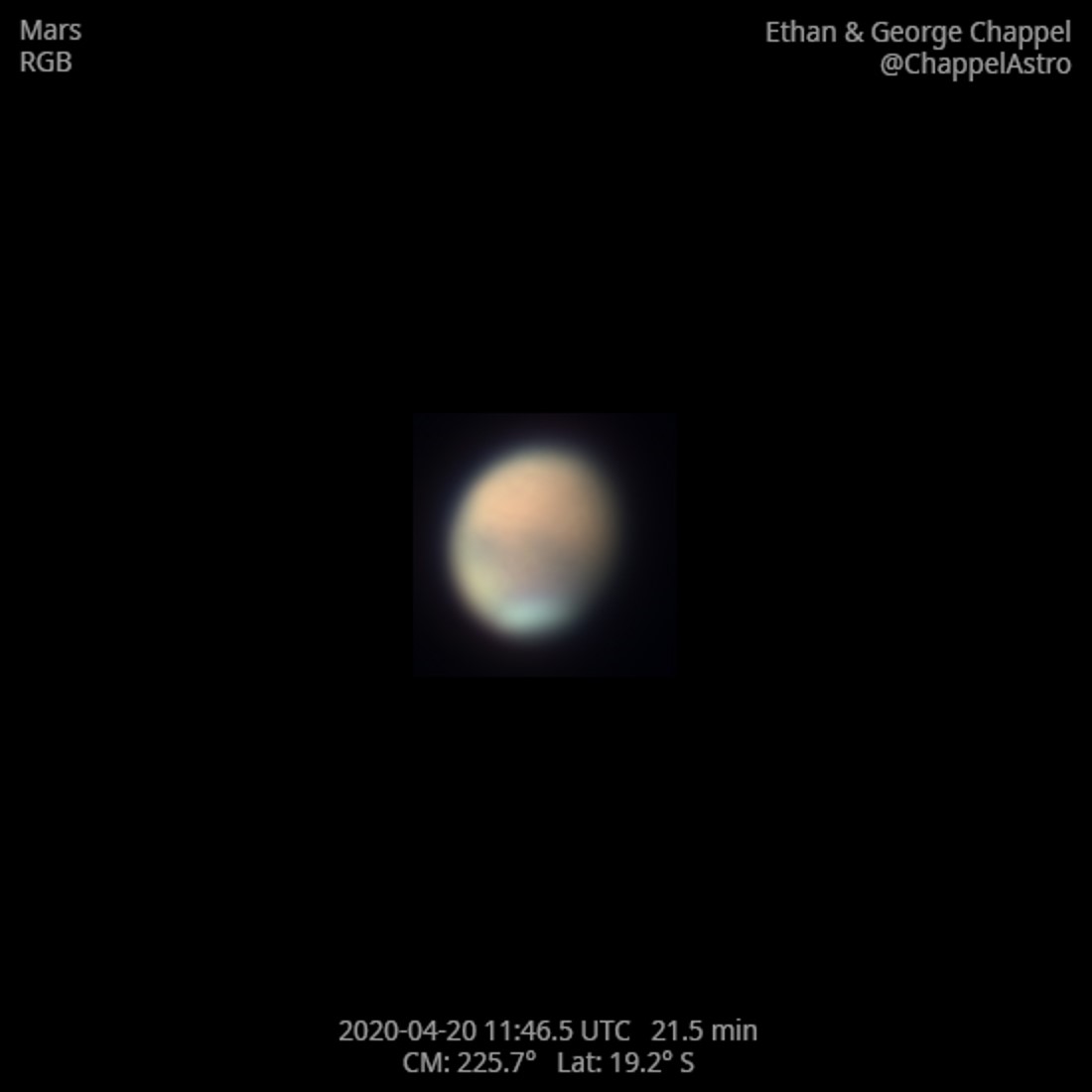
Mars Image 2020/04/20(UT)
熊森照明
Clyde Foster,Ethan Chappel
C.Foster,T.Kumamori,E.Chappel

解説(安達)/ Comment by Makoto Adachi Clyde Foster氏の白雲の右側のものは。アルシア・シルバ山である。(Arsia Silva Mons;W120,-3)オピール(Ophir;65W,-7) 付近の白雲が記録されている。ソリス(Solis Lacus;W90;-28)周辺のタウマシア(Thaumasia Foelix;70W~105W,-30~-43)はかなり 暗く、ソリスを単独の暗斑に見るのは難しい。 熊森氏はメリディアニ(Meridiani;0W,-5)付近を観測した。SPCから出ているように見える明るい帯を記録している。青画像で白く 見えないところから判断すると、エッジダストストームの痕跡と考えるのがよさそうである。この一帯は、淡くダストベールに覆われて いる地域だが、実際より暗く表現されているように見える。マリガリティファー(Margaritifer Sinus;23W;-10)の南に東西に 延びたダストベールの濃い部分が横たわっているのが興味深い。デウカリオニス(Deucalionis Regio;330W~10W,15)と、 このダストベールはつながっているようだ。ヘラス(Hellas;275~315W,-30~60)の位置にかすかに夕霧が記録されている。 The one to the right of Mr. Clyde Foster's white cloud. It is Alcia Silva Mons. Arsia Silva Mons (W120,-3) White clouds near the Ophir (65W,-7) are recorded. TThaumasia Foelix (70W ~ 105W,-30 ~ -43) around Solis Lacus (W90; -28) is quite dark,and it is difficult to see Solis as a single dark spot. Mr. Kumamori observed near Meridiani (0W,-5). It records the bright bands that appear to come out of the SPC. Judging from the fact that it does not appear white in the blue image,it seems to be considered a trace of edge dust storm. This area,which is lightly dust-veiled,appears darker than it really is. It is interesting that the dark part of the dust veil extending from east to west lies to the south of Margaritifer Sinus (23W; -10). Deucalionis Regio (330W ~ 10W,15) and this dust veil seem to be connected. A faint fog is recorded at the position of Hellas (275 ~ 315W,-30 ~ 60). (by 2 observation; reported by Makoto Adachi)-------------------------------------------------------------------------------------
| Clyde Foster |
There is still some (slight) residual cloud over Arsia Mons as well as late afternoon equatorial cloud at left. Valles Marineris is center left and Solis Lacus at upper left.[Clyde Foster:Centurion,South Africa]
| Teruaki Kumamori |
中々まともに晴れず、雲の中での撮影となりました。≪大阪府堺市 熊森照明≫[Teruaki Kumamori:Ohsaka Japan]
| Ethan Chappel |
Seeing was tough for Jupiter & Saturn, but it took a turn for the worse by the time I reached Mars. I only used the best 5% of frames, the lowest for any set of images since I started planetary imaging over six years ago. Notes: Hellas Basin, which appears to be obscured by a bright dust cloud, is rotating into view.
[Ethan Chappel Cibolo,Texas,United States]
 ALPO-Japan Latest ALPO-Japan Latest

 Mars Section Mars Section
2020/04/21
| 2020/04/19
| |